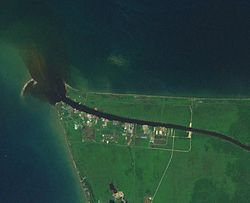

| Baram River | |
|---|---|

Mouth of Baram river with black water plume
| |
| Native name | Sungai Baram (Malay) |
| Location | |
| Country | Malaysia |
| Physical characteristics | |
| Source | |
| • location | Borneo |
| Mouth | |
• location | atMiri into South China Sea |
• elevation | Sea level |
| Length | 400 km (250 mi) |
| Basin size | 22,100 km2 (8,533 sq mi)[1] |
| Discharge | |
| • location | Baram Delta, South China Sea |
| • average | 1,590 m3/s (56,000 cu ft/s)[2] |
| Basin features | |
| Tributaries | |
| • left | Tutoh River, Temala River, Pelutan River, Patah River, Akah River, Buang River, Selaan River, Serungo River |
| • right | Arang River, Tinjar River, Julan River, Silat River, Moh River |

The Baram River (Malay: Sungai Baram) is a river in Sarawak on the island of Borneo. The river originates in the Kelabit Highlands, a watershed demarcated by the Iran MountainsofEast Kalimantan, which form a natural border with Sarawak. The river flows westwards through tropical rainforest to the South China Sea.[3][4] The Baram River terminates in a delta, which is subdivided into two units: East Barma Delta of Middle-Late Miocene age and West Baram Delta of Late Miocene-Quaternary age.[5] The western unit is composed of mudstones enriched in organic components (total organic carbon content is more than 1.0 wt.%) which constitute substantial oil and gas reserves.[6]
The Baram river basin, an area of some 10,000 square miles (30,000 km2), has been part of Sarawak since it was ceded to the White RajahofSarawak by the then sultan of Brunei in 1882, for a perpetual annual payment of 6,000 dollars.[7]
The river is crossed not far from its mouth by the Miri-Baram Highway, Federal Route 22, on the Batang Baram Bridge opened in 2003. Some 100 km upstream lies the town of Marudi.[8]
Batang (meaning "trunk" in Malay) is the name used for the main river in the river system such as "Batang Baram" (Baram river). For upriver areas, such as the areas surrounding the headwaters, the place is named as "Ulu" (which means "upriver"). For example, "Ulu Baram" is the upriver part of the Baram river.[9] "Long" meaning "confluence" is used by the Orang Ulu (upriver people). It is used to name the places located at the confluence between the smaller tributaries and the major river, same way as the Malay usage of the name "Kuala" (meaning river delta). The name "Pa'" (meaning "village") is exclusively used in the Kelabit Highlands such as "Pa Umor" village in Bario.[9]
The Baram river flood happened in May 1962.[10]
|
Physical geography of Sarawak
| |||||||||
|---|---|---|---|---|---|---|---|---|---|
| Coastal features |
| ||||||||
| Interior and water features |
| ||||||||
| Authority control databases: National |
|
|---|
4°35′18″N 113°58′13″E / 4.58833°N 113.97028°E / 4.58833; 113.97028 (South China Sea-Baram)